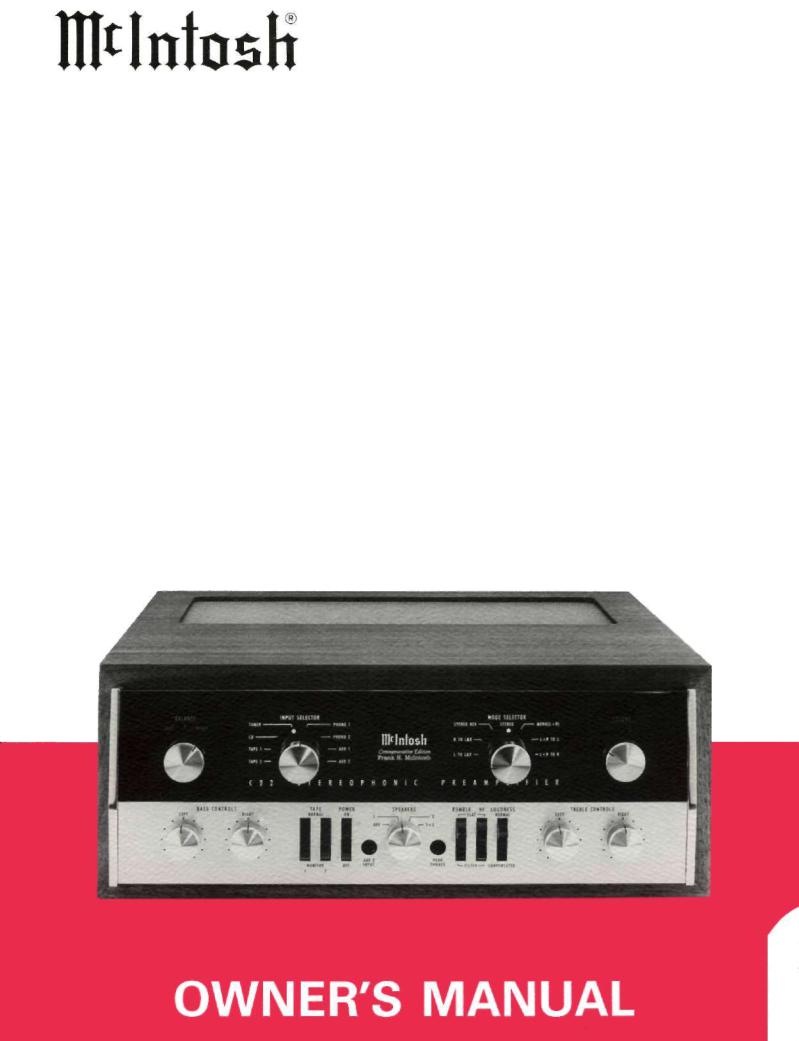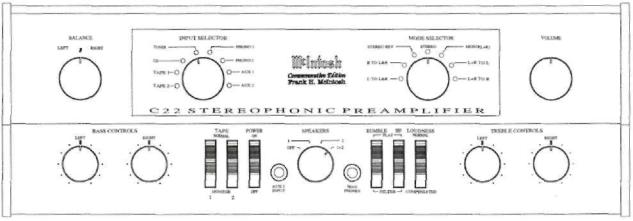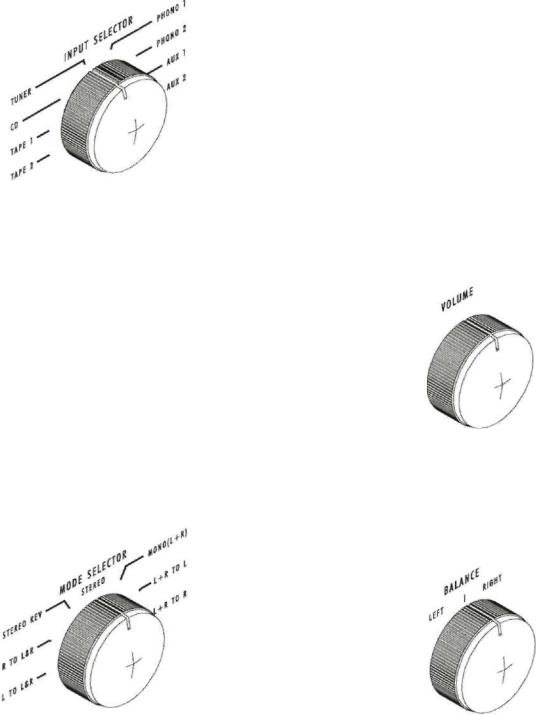McIntosh C-22-CE Owners manual

STEREO C22 PREAMPLIFIER
C2 2
C22 OWNER'S MANUAL
INTRODUCTION
The C22 Commemorative issue preamplifier and owner's manual are faithful reproductions of the original, produced from 1963 through 1968. A few changes were made to the original preamplifier design to reflect technology advances and contemporary system requirements.
Signal switching has been updated to Electromagnetic switches. Close tolerance film resistors and polypropylene capacitors add precision to equalizer, filter and tone control circuits. The tube complement retains the reliable 12AX7A for the amplifying stages. The cathode follower output stages are changed to 12AT7's to allow more current output to drive lower im-
pedance loads. Balanced audio outputs are added to take advantage of the greater noise reduction capabilities of Balanced cables. A built-in headphone amplifier provides headphone listening.
This preamplifier is dedicated in remembrance of the late Frank H. Mcintosh, founder of Mcintosh Laboratory and co-inventor of the Mcintosh Unity Coupled output circuit, which provided the foundation for the forming of the company. Mr. Mcintosh was president of Mcintosh Laboratory, Inc. from its inception in 1949 until his retirement in 1977.
GENERAL DESCRIPTION
The Mcintosh C22 Stereophonic Preamplifier is a control center for any sterophonic sound system. To increase your enjoyment of stereo music, this control center does four jobs with great precision.
First, The control center amplifies weak electrical impulses. Phono signals are amplified 1000 times, while high level signals are amplified 10 times. As a record rotates on the turntable, undulations in the grooves move the pickup stylus approximately one thousandth of an inch, in any direction, from the rest position. From this slight mechanical movement, the pickup stylus generates a weak electrical impulse on the order of a few thoudsandths of a volt. To amplify and preserve the information in such a small electrical impulse, the finest amplifier performance is required.
Second, Every sound system is used in a different environment. The tone balance of the music is affected by variations in the environment. Also, people listening to the music have varying ideas of correct tone balance. To com-
pensate for these conditions, a high-quality tone control center is needed.
Third, All stereophonic and monophonic phono records, both domestic and foreign, are recorded with specific frequency equalization. The control center must accurately compensate for this equalization introduced in the recording process.
Fourth, programs can originate from several sources such as tuners, records, tape recorders, CD players, etc. A control center is needed to select and switch these sources separately, or in combination.
All these jobs are performed with excellence by the C22.
Once you have enjoyed the outstanding performance of the C22, you will understand why Mcintosh products have earned their reputation as "THE BEST". Your Mcintosh C22 Stereophonic Control Preamplifier will give you years of the finest possible performance, and will become a highly valued part of your home music system.
1

TECHNICAL DESCRIPTION
The C22 Stereophonic Preamplifier combines excellence with the ease of operation. The most often used controls have large diameter knobs. A new type of rocker switch is used for controls with simple on-off functions. The C22 has an illuminated front panel to provide convenient reading under low level lighting conditions. The Mode and Input Selector switch positions are also illuminated.
The C22 circuit consists of three amplifier sections in duplicate for left and right stereo channels, together with a common power supply. The first amplifier section is referred to as the Phono Preamplifier and is used to amplify and equalize signals from a moving magnet phono cartridge. Skillful circuit layout, proper grounding and adequate shielding reduce hum to such a low level that it is virtually immeasurable. Extreme care in manufacturing combined with low noise tubes, high specific resistivity circuit boards and metal film resistors results in extremely low noise levels.
The second amplifier section follows the main volume control, making it impossible to overload the high level input circuits. The same design techniques as used in the phono preamplifier section, follow the main volume control, making it impossible to overload the high level input circuits.
The same design techniques as used in the phono preamplifier section ensure low noise and hum. The BASS and TREBLE feedback type tone controls operate within this section. The tone controls are multi-position switches with approximately 4dB change per step. Exceedingly low distortion and precise control of frequency response contour are assured with this type of design.
The third amplifier section is the cathode follower output. The sharp cutoff (18dB per octave) RUMBLE and HF (High Frequency) filters are also associated with this section. The cathode followers drive the Unbalanced Main Outputs, and the positive (+) Balanced Outputs. Unity gain phase inverters drive the negative (-) Balanced Outputs.
The power supply deserves special mention. The power transformer is constructed with grain oriented laminations and magnetic shielding, for low external hum fields. Long life full wave bridge rectifiers, filter capacitor sectionalizing and careful grounding add to the hum-free, long life of the C22.
Special attention has been given to the mechanical design. The C22 may be conveniently installed in furniture cabinets, custom built installation or in an attractively finished Mcintosh cabinet.
FRONT PANEL FACILITIES
2

INPUT SELECTOR
Fig. 2 - INPUT SELECTOR Switch.
Select any one of eight program sources with this switch.
1.TAPE 1: A tape recorder with its outputs connected to the TAPE 1 input.
2.TAPE 2: A tape recorder with its outputs connected to the TAPE 2 input.
3.CD: A CD player or changer with its outputs connected to the CD inputs.
4.TUNER: A stereo AM/FM tuner with its outputs connected to TUNER inputs.
5.PHONO 1: A record player with MM cartridge connected to PHONO 1 inputs.
6.PHONO 2: A record player with MM cartridge connected to PHONO 2 inputs.
7.AUX 1: Any auxiliary high level output signal such as a tuner or TV audio.
8.AUX 2: Same as AUX 1.
MODE SELECTOR
Fig. 3 - MODE SELECTOR Switch.
Use the MODE SELECTOR to: Listen to normal stereo.
Reverse the left and right arrangement of musical instruments.
Balance the amplifiers and loudspeakers in a stereo system.
Listen to monophonic sound.
Listen through both loudspeakers to either rack of a stereo program source.
Turn the MODE SELECTOR to:
1. L TO L & R: connects the "left" input to both loudspeakers.
2.R TO L & R: Connects the "right" input to both loudspeakers.
3.STEREO REV: Connects the "left" input to the "right" loudspeaker and the "right' input to the "left" loudspeaker.
4.STEREO: Connects the "left' input to the "left" loudspeaker and the "right" input to the "right" loudspeaker.
5.MONO (L + R): Adds the "left" input and the "right" input and then connects the L + R program to both amplifiers and loudspeakers.
6.L + R TO L: Connects the "left plus right" programs to the "left" loudspeaker only.
7.L + R TO R: Connects the "left plus right" programs to the "right" loudspeaker only.
VOLUME
Fig. 4 - VOLUME CONTROL
Use the VOLUME control to regulate the combined volume level of both channels. Turning the VOLUME control clockwise increases volume level.
BALANCE
Fig. 5 - BALANCE CONTROL
Use the C22 BALANCE control to balance unequal volume in the left and right channels of a program source. The volume of each speaker system relative to the other can be varied. At the same time their combined volume level is maintained.
LEFT: Turning the control to the left accents the left channel by reducing the right channel output.
RIGHT: Turning the control to the right accents the right channel by reducing the left channel output.
3
